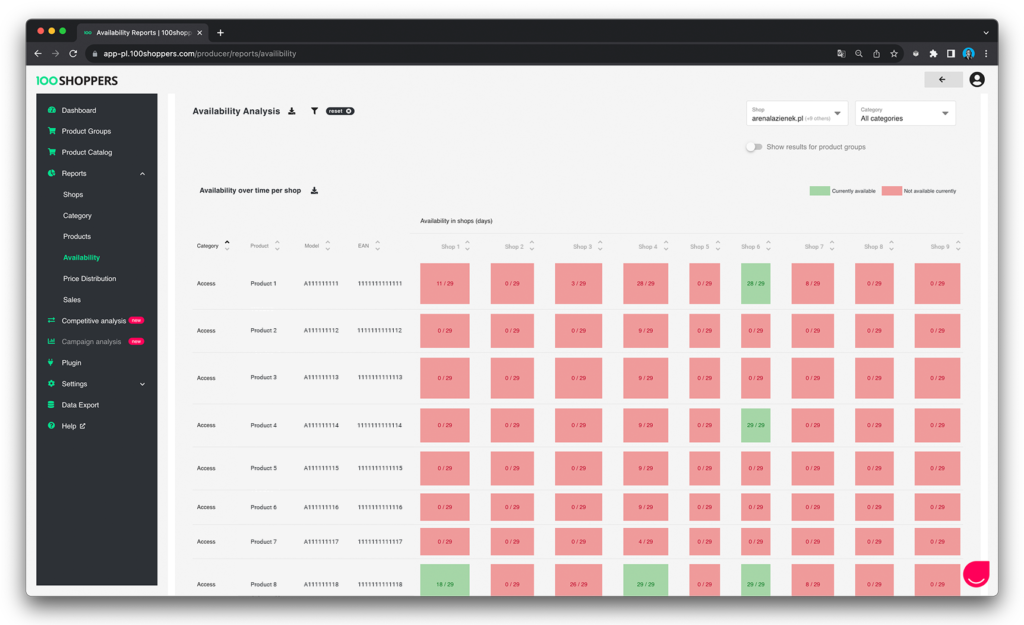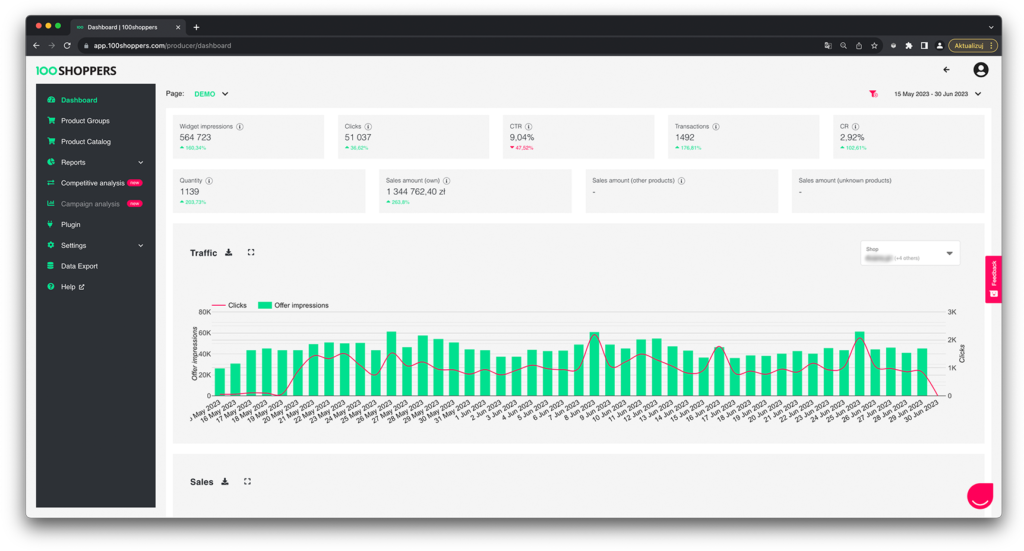With the ecommerce market becoming a more and more prominent branch of global retail trade, a growing number of manufacturers decide to step up their game by expanding their distribution network by an online channel.
Estimated to amount to 6.3 trillion dollars in 2023, ecommerce retail has been synergizing with the more traditional offline sales channels neatly, offering an integrated, yet radically new product interaction and original shopping experience.
As for manufacturers, sales organized via the offline and online distribution networks can help them reach different consumer groups, based on buyers’ preferences, shopping habits, or their interaction with the brand. However, unlike traditional sales, the online channel opens up the business to global strategic partnership with a number of online platforms and, in effect, to global purchasing power.
Broadly speaking, the role of an effective distribution strategy is targeting the right customer in the right time and location. What that means, of course, is that we want all our products to reach all our customers anywhere and everywhere, providing the best experience possible.
In the modern market, however, this goal cannot be achieved by relying solely on the traditional sales models. While we might have built with our offline sales strategies a strong and enduring brand, while enjoying loyalty from a solid and varied customer base, without an online channel we would be limiting the potential of our brand to the local market exclusively.
The multichannel model, where a brick-and-mortar store operates in sync with an online platform, is already a step towards establishing global presence. Yet, presence or brand recognisability itself cannot guarantee a boost in sales in a market environment known for its high maintenance costs and strong competition from no longer local, but also international powerhouses.
Today, the online distribution model that has proved to be radically effective for manufacturers aiming to scale up their business in a competitive market environment is the external point of sale model, where buyers have access to our goods from selected online channel partners.
In this example of cooperation with Casio, the brand decided to branch out their sales beyond only their proprietary channel towards a distribution model from a number of platforms. This change of strategy brought about a staggering effect of a 400% increase in sales!
How to run an effective distribution strategy to net such results and make the most of the growing online sales trends?
Keep reading for the most common challenges of strategy adjustments and the most actionable solutions for manufacturers.
The most common online distribution challenges faced by manfacturers
Expanding one’s business across online distribution channels can be challenging in a number of ways. Perhaps the most obvious one is fierce competition.
Like our goods, our brand attractiveness comes under scrutiny from customers and gets meticulously ranked by the buyers. Meeting customer expectations when it comes to navigability of our website often means allocating the bigger part of our resources to both technical upgrades and keeping the site compelling and visually attractive.
Next, maintaining an independent online sales channel will consume a significant part of our operational budget, which, together with the daily costs of logistics, order processing, or dealing with complaints, is going to bite our revenue noticeably.
Another vast expense to be taken into consideration when planning the budget for expansion is promotion. Whatever sums of money we invest into promoting our products, one online distribution channel leaves us with only one receiving end to capture all the traffic our marketing efforts have generated.
Why might the one-channel strategy become a fiasco?
Shopping online, customers can compare offers from any distributors in one click. In fact, most buyers choose that option when searching for:
- cheaper offers,
- alternative delivery or payment options,
- more flexible returns policy,
- value-added services, e.g. insurance,
- better customer service,
- secure purchases,
- alternative products,
- attractive captive product pricing,
- green logistics solutions.
As manufacturers, we can actively shape our customers’ path to purchase already on this level by offering them some or all of those options through our partnering distribution channels.
In fact, by using online downstream operators, we can effectively decrease bounce rate by offering shoppers a search and price comparison experience that they covet. This has shown to prevent customers from taking their interest, business and data somewhere outside our distribution network.
Imagine a client browsing through our website. When they find a product they like, they see a list of authorized, reliable dealers carrying that item in different price ranges and with different shipping options that the customer can choose from. Locking customer’s interest in a variety of options allows us to retain them in our distribution network as it gives the client a unique, customized shopping experience. Increased shopping satisfaction will more often than not turn a random shopper into a repeat customer, which is yet another argument that an effective sales strategy must involve many sales channels.
A strategy built on multiple distributor cooperation makes reaching wider consumer groups and addressing different shopping preferences quicker and more precise. At the same time, such a coherent strategy requires curated tools and well-knit process planning.
A challenge ahead of any online sales channel is attracting and, more importantly, retaining user’s attention.
- How can we tie customer’s attention to the selected product while redirecting them from site to store?
- Also, how to manage relations with a number of partnering, yet mutually competitive stores?
- How can we manage issues in distribution channels?
Keep reading to find answers to those vital questions.
How the 100Shoppers tool can help brands (manufacturers) to build solid online distribution
According to the Coface report, as many as 2125 business enterprises had to declare bankruptcy in 2021, which amounts to 71% more than the year before. Global data shows that 79% of businesses rank the COVID-19 pandemic among main reasons behind the increased investment in digital transformation. Addressing changing customer expectations was cited as the driving force of the mid-pandemic digitalisation boom.
The above data being a reflection of the economic turmoil in the times of the pandemic, to a large degree it also represents business agility of commercial enterprises across the board. It shows which companies have proved internet-worthy and, understanding the opportunity as it presented itself, have been able to successfully expand their business online.
The conclusion we can draw from the stories of successful transformations from the off- to the online model is that modern technological solutions are the cornerstone of effective competition and an airtight standard against certain types of economic crisis.
An indirect aftermath of the pandemic was the increased demand for effective digitalisation systems and tools. A number of solutions were created that offer a substantial range of functionalities along a friendly interface. It turns out that, with the help of such tools, businesses can win a sound competitive advantage over the more traditional rivals.
When it comes to product distribution online, one of such tools dedicated to manufacturers is the 100Shoppers solution. Our application provides a wide range of ready-made functionalities, geared to delivering the best shopping experience to your customers.
What is more, the 100Shoppers tool offers you an operational framework for the entire multichannel distribution with any and all of your online downstream operators.

The tool consists of a widget displaying a list of stores together with the analytical framework for better sales management. The widget cuts short the customer’s path to purchase by taking them directly from the product page on the manufacturer’s website to correspond one at a selected online store. It’s important to note that the list of stores displayed in the widget changes dynamically, as the system shows only the stores that currently have the product on offer.
Let’s look at the main functionalities within the 100Shoppers widget:
- securing the customer in our distribution network,
- minimizing the risk of losing our potential customer to our competition,
- optimizing and fail-proofing customer’s path to purchase,
- dynamic offer display in the widget.
Overall, with 100Shoppers you can monetize quality traffic on the brand’s manufacturer website directly in partnering online stores.
Collecting and analyzing data in the distribution process
Let’s move on to the analytical framework of the 100Shoppers widget. The tool generates a number of custom reports for the manufacturer, and collecting such data and keeping track of variables allows us to quickly verify if our distribution strategy is bringing the desired outcomes.

The 100Shoppers app carries data on traffic, product availability, prices and sales results (also for specific product categories), both in real time and distributed over the selected sales period.
Manufacturers count product availability reports among the most vital data sources, as they can quickly pinpoint those stores that might require urgent restocking. What is more, the app-sourced data can be exported to external sales management tools, where it can be compared against the data from the domestic website or other internal systems in order to obtain a multilayered representation of our commercial performance.
Cooperating with multiple partners in one distribution network
Managing cooperation among a number of partners requires solid organization and closely following sales development over time. In a model where a number of independent distributors cooperate with a brand towards successful product sales, but at the same time also aim to reach their individual goals, a robust sales policy is an absolute must.
What will help in this endeavor is monitoring the traffic from the brand’s manufacturer website. This process should be accompanied by product availability and sales results analysis. Keeping this data under control with the 100Shoppers widget will allow us to build coherent communication with our partners and can become a leverage in our negotiations with the distributors.
The 100Shoppers tool will also support managing the restocking process with your partners. You can follow the performance of your products in partner channels in real time and react accordingly if your partners experience bottlenecks or require replenishment.
Conflicts in the distribution network
For the manufacturer, the biggest threat in the multichannel retailing model are horizontal conflicts, that is when two or more sellers are at cross purposes.
As the stores aim their marketing message at a similar or often the same group of users, conflicts of interests among the retailers seem unavoidable.
The worst case scenario is that the fierce competition among sellers can lead to an all-out price war, which is highly detrimental to manufacturer’s interests.
A price war can lead to:
- decline in brand’s value,
- slack, when customers postpone their purchase waiting for another attractive discount,
- increased returns, when customers feel cheated having bought a product at a much higher price,
- lower customer’s trust factor and damage to brand’s credibility.
As prevention is better than cure, the first step in forestalling such conflicts is using our position as a brand (manufacturer) to establish beneficial conditions of cooperation. The groundwork for successful cooperation among retailers is a uniform and coherent pricing policy, firmly setting the minimum prices on individual products in all partnering stores.
Case study: Casio
One of the best illustrations of what expanding distribution with 100Shoppers can do for manufacturers is the example of Casio, one of the leading manufacturers in the music industry.
Originally, Casio was running its retail operations via its own online store, however, with high bounce rate and low in-site sales, achieving results that were far from satisfactory.
Implementing the 100Shoppers application with the embedded Where To Buy widget allowed for the integration of the manufacturer’s store with multiple online points of sale, significantly expanding the distribution network.
Increased selection across prices and delivery options on the side of the customers, as well as the real time tracking of customer’s path to purchase on the side of the manufacturer boosted sales made via Casio’s original website by no less than 400%.
Replacing the B2C model with a hybrid of B2B2C helped Casio develop its distribution network to respond to customer demand and made targeting larger client groups possible, all of which translated into an unprecedented increase in revenue.
In conclusion
As we have seen, running a healthy and successful business on the ecommerce market is a combination of the market potential and taking the opportunity when it arises. And today this potential can be tapped into only if we bring state-of-the-art technological solutions on board that can turn a random chance of success into a well-planned strategy.
Competing effectively, attracting and retaining users’ interest, providing positive shopping experience, collecting reliable data that support our sales strategies, and managing relations with our partners in a harmonious, conflict-free manner – are all among the main challenges of operating a sustainable business.
Facing those challenges in a well-developed and safe technological environment that 100Shoppers provides with its Where To Buy widget is an opportunity that can be turned into a coherent, successful strategy.








